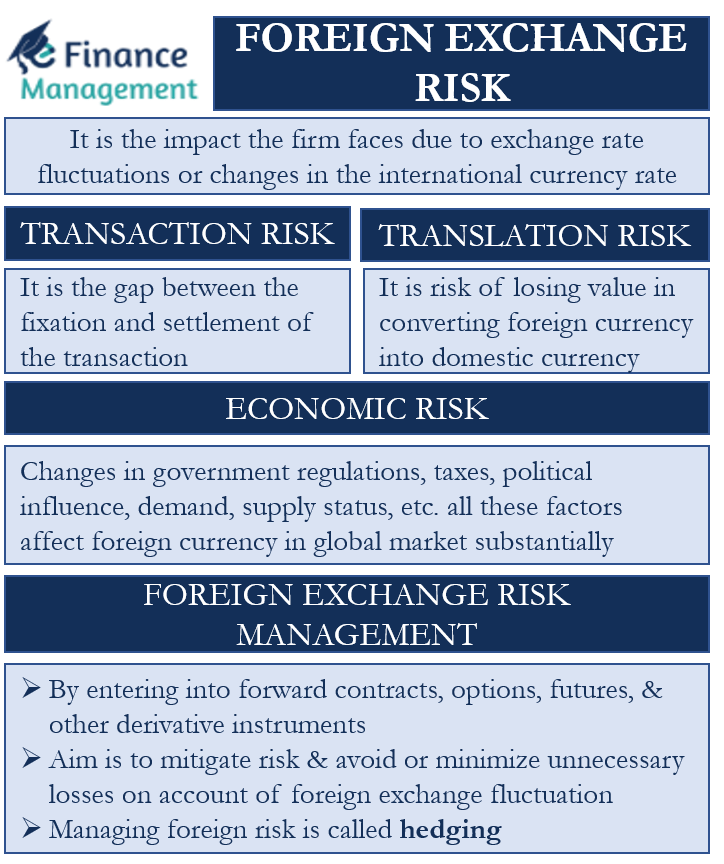International finance is a complex subject. There are a variety of risks involved with it, including credit risk, foreign exchange risk and legal risk.
Eliminating risk is impractical and very expensive, but understanding it can help you mitigate its impact. In this article, we will examine the types of risk in international finance and how they can affect your business.
Currency Risk
Foreign currency risk, also known as FX or exchange-rate risk, is the possibility that an investment or transaction will incur losses due to changes in the relative valuation of currencies. This type of risk primarily affects investors or companies that have assets or business operations across national borders. Fortunately, there are a variety of tools and strategies available to reduce the impact of foreign currency risk.
One common way to manage foreign currency risk is through hedging. In this strategy, businesses and investors use currency derivatives such as forward contracts, options and futures to hedge against the effects of changing exchange rates. However, these instruments can be costly and complicated for individual investors. An alternative to these complex tools is the use of currency-focused exchange-traded funds (ETFs).
Another method to reduce currency risk is through operational hedging. This involves adjusting a company’s business processes to mitigate the effects of currency fluctuations. For example, a company could require that all sales transactions be invoiced and paid in the home currency. This would pass the risk of changing exchange rates to its local customers and suppliers.
Finally, a company could also reduce its exposure to changing exchange rates by incorporating currency clauses into its contracts. This would allow companies to negotiate a price in a particular currency while locking in that price for a certain period of time.
Country Risk
Country risk is the level of uncertainty connected to investing or doing business in a foreign country. It encompasses factors such as inflation, currency fluctuations, economic instability, political events and potential repercussions of war, civil unrest and movements intended to bring about societal change. In addition to these specific country-related issues, the business environment itself can also pose a potential risk based on factors unique to that particular location. These include tax laws, interest rate hikes and any changes in government policies that could impact international trade or cash flows into and out of a country.
A company conducting business internationally needs to assess its own level of country risk and develop a strategy accordingly. The level of risk can affect the profitability of international operations and the overall financial stability of a company. For example, companies that do business in developed countries generally have less country risk than those in emerging or frontier markets. Country risks filter through the domestic financial system, and the entities that issue equities and bonds that traders and investors add to their portfolios in search of attractive returns are affected by this risk.
Country risk is typically divided into three sub-categories: economic, political and financial. Economic risk is based on the performance of the country’s economy and its ability to repay debt. Political risk reflects the country’s government and its ability to honor commitments. Financial risk, meanwhile, is a risk of default on loan obligations.
Tax Risk
Tax risk is the uncertainty of future tax liabilities, whether they are in the form of capital gains or withholding taxes. This can be a significant expense for companies operating internationally, as well as a major source of reputational damage. Managing tax risks is an ongoing process that requires careful planning, transparent communication, and collaboration with tax authorities, as well as the use of internal and external expertise.
A clear and structured tax governance framework enables a robust risk culture aligned with the ambition and strategy of the organisation. This should include a risk appetite statement, accessible internal reporting channels and assurance plans. A well-managed governance framework ensures that operational tax risks are properly identified, assessed and mitigated.
These operational taxes typically relate to business activities and operations architecture, including financial transactions taxes (such as FTT), indirect taxes (including withholding taxes) and transfer pricing. These are largely related to the way in which a company operates, its supply chains and any corporate actions such as share buybacks, sales or transfers of assets between group entities.
An effective risk management framework should be holistic, embedded in the broader risk management processes of a business and facilitated by a qualified team of tax professionals. These tax professionals should be trained and experienced enough to make judgements on complex matters, augmented by specialist advice from external specialists where necessary.
Liquidity Risk
Liquidity risk is the risk of being unable to convert short-term debts and assets into cash within a reasonable time frame. It is generally a cyclical risk and occurs during economic downturns. A business with a high liquidity risk is likely to struggle in times of low market demand or when interest rates are volatile.
All businesses need access to capital for both long-term strategic investments and to meet short-term financial obligations, such as payables and receivables. Insufficient or slow access to funding can create liquidity problems, which threaten the ability of a company to fulfil its financial obligations.
There are two main types of liquidity risks: market and funding. Market liquidity risk refers to the difficulty of buying or selling an asset at a fair price because of a lack of buyers or sellers in the market. Funding liquidity risk, on the other hand, refers to the ability of a financial institution to access funding to cover its current-assets maturity mismatch.
Both market and funding liquidity are critical in global finance. Insufficient liquidity can lead to a number of problems, including insolvency. It is therefore important for businesses to thoroughly understand their sources of liquidity, and the principles of measuring and managing liquidity risk. This will allow them to be prepared for any future financial challenges and ensure they have enough working capital to pass various stress tests.





